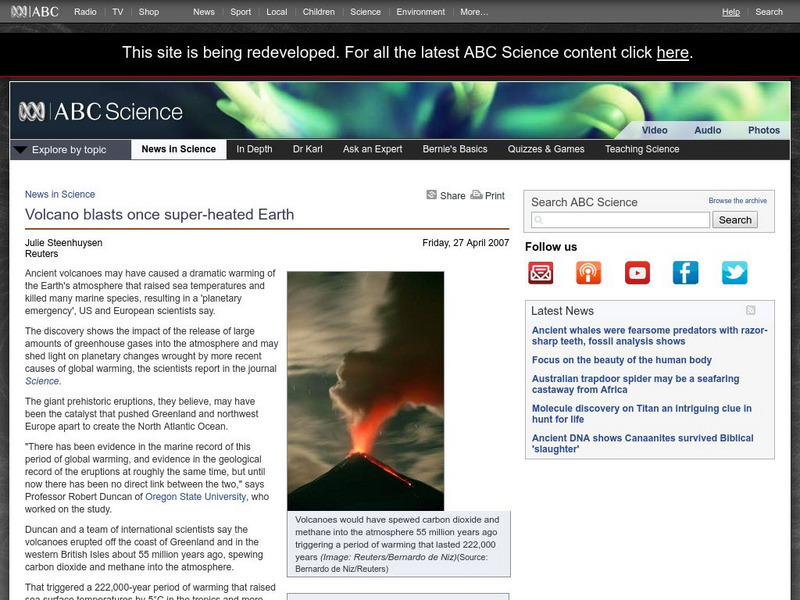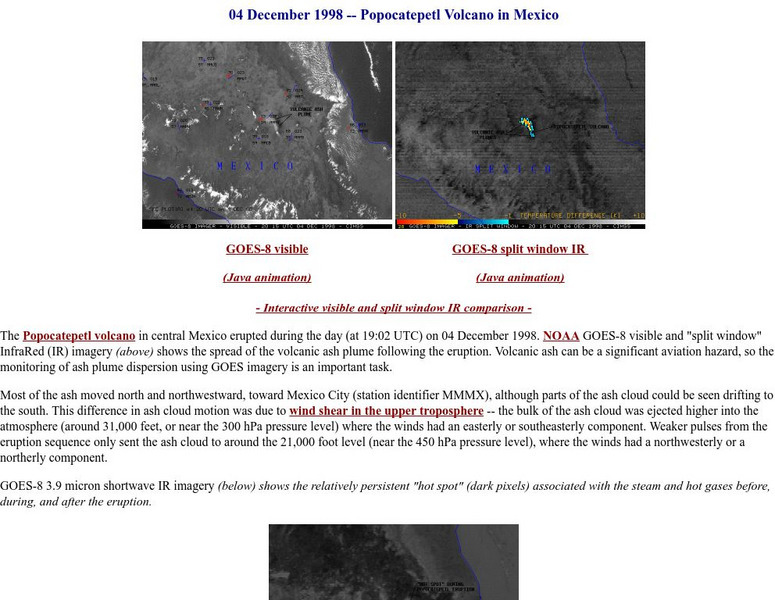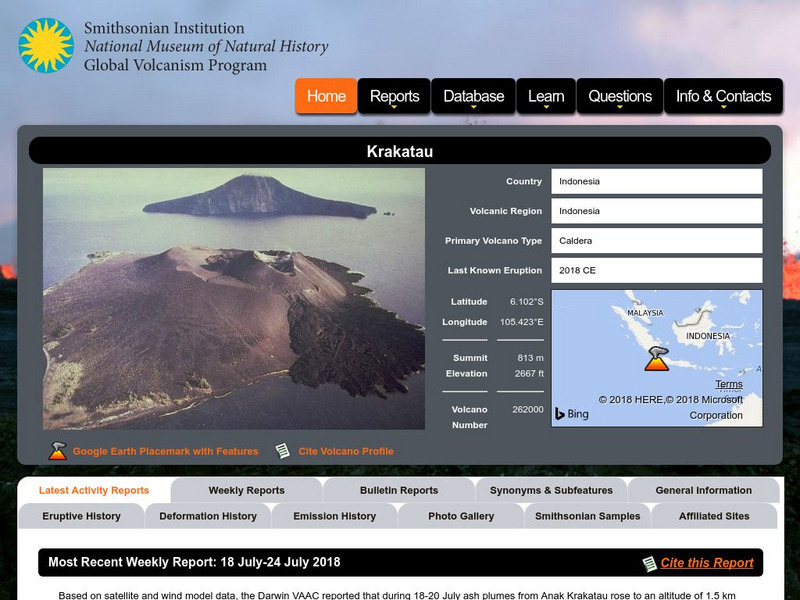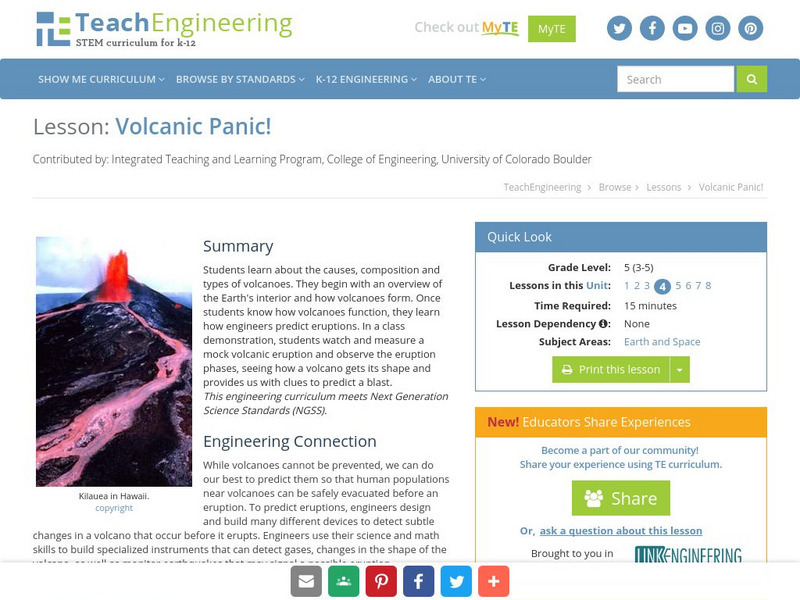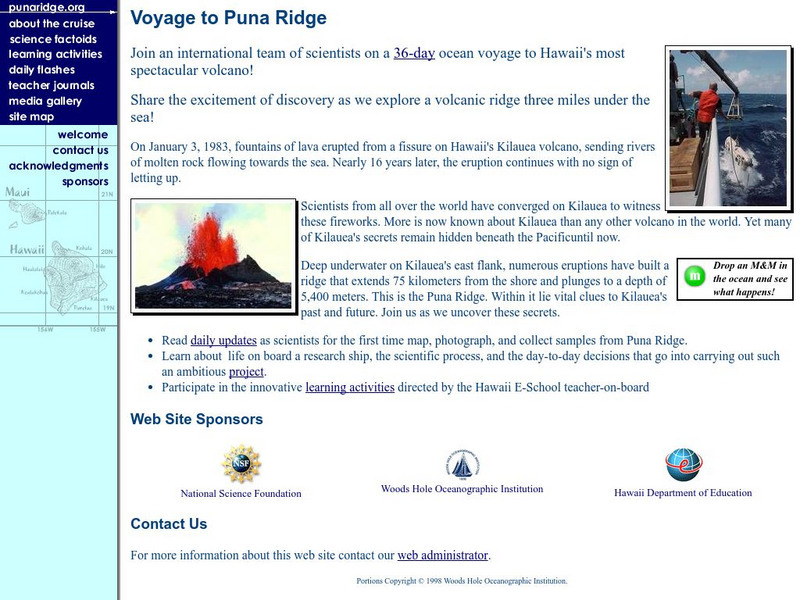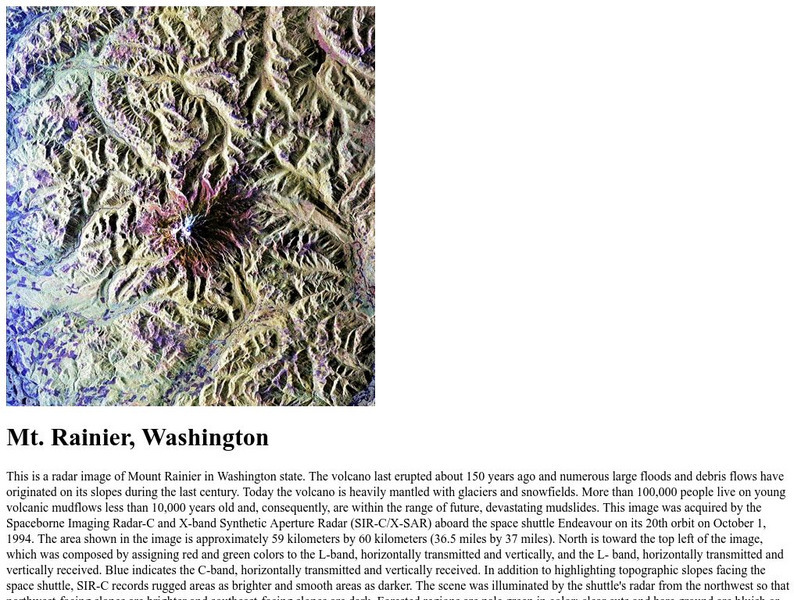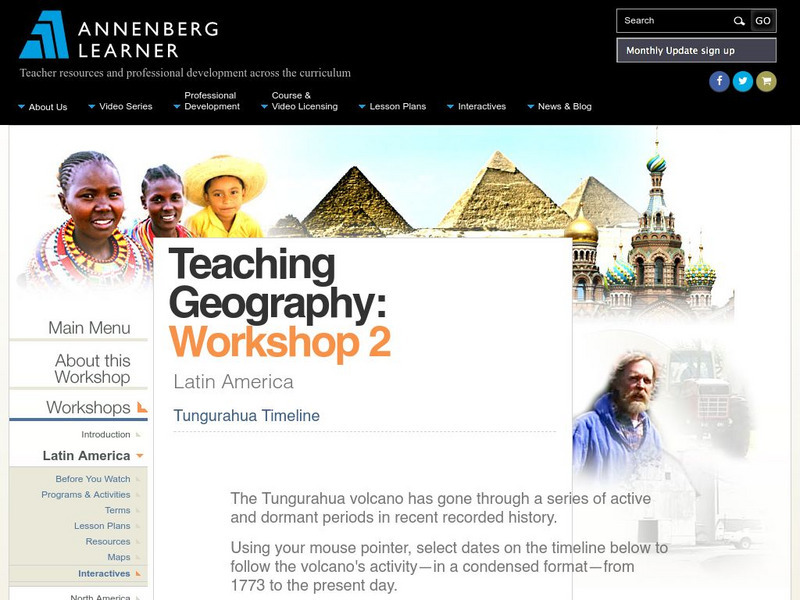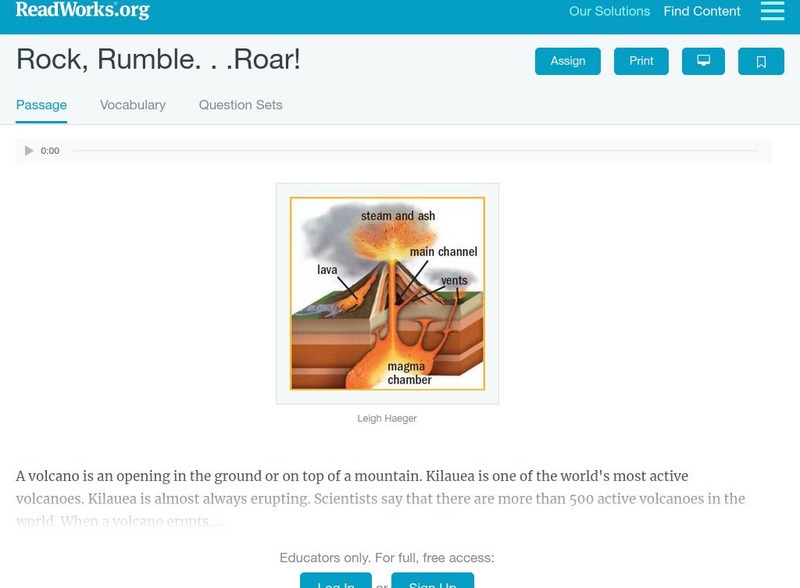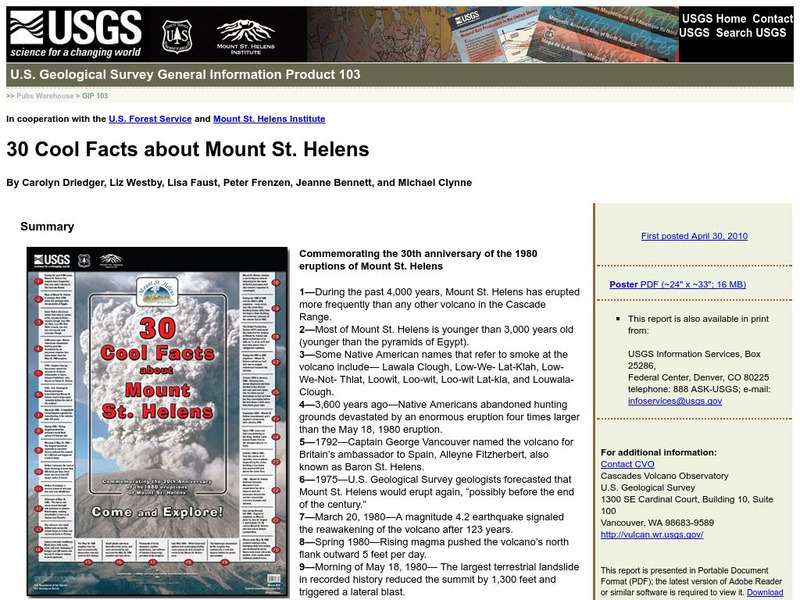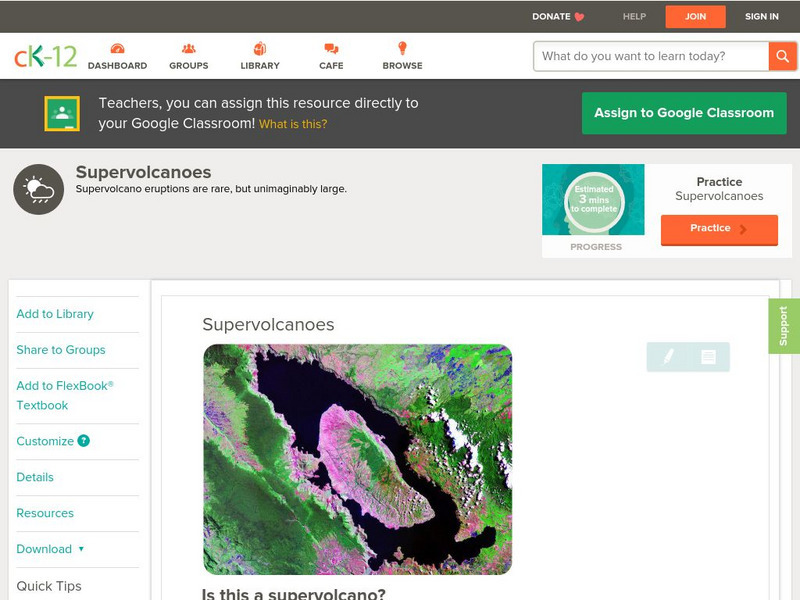Hi, what do you want to do?
University of Wisconsin
The Why Files: Volcanic Activity
A resource to help understand how volcanoes work and how the can affect their surroundings.
California State University
Csu: The Sourcebook for Teaching Science: Earth Systems Interactions
Explains what the four spheres of the Earth are and describes how volcanic eruptions affect the different spheres. Also provides a list of events that are examples of interactions.
Curated OER
Merriam Webster: Visual Dictionary Online: Volcano During Eruption
Labeled diagram of a volcano during an eruption.
Australian Broadcasting Corporation
Australian Broadcasting Corporation: News in Science: Volcano Blasts Once Super Heated Earth
From ABC News in Science, Julie Steenhuysen's article explores the results of ancient volcanic eruptions that caused a warming effect on the Earth and possibly caused the death of certain species.
University of Wisconsin
University of Wisconsin: Popocatepetl Volcano in Mexico
General information on the Mexican volcano. View graphics of Popocatepetl and learn about the eruption process.
Wikimedia
Wikipedia: Mayon Volcano
A Wikipedia entry on the Mayon Volcano, the most active volcano in the Philippines. Excellent photos and maps. Includes a log of recent eruptions.
Australian Broadcasting Corporation
Australian Broadcasting Corporation: News in Science: Vesuvius (World's Most Dangerous Volcano)
An article outlines the reasons why Vesuvius should be considered the world's most dangerous volcano.
ClassFlow
Class Flow: Plate Tectonics Volcano
[Free Registration/Login Required] This lesson will take several class periods. This lesson begins to look at how volcanoes are created.
Smithsonian Institution
National Museum of Natural History: Global Volcanism Program: Krakatau
The volcano Krakatau is in Indonesia. Learn about its background information, description, frequently asked questions, items of interest and useful links.
PBS
Nova: Seismic Signals
Scientists have determined that the earthquakes preceding volcanic eruptions are different than those that precede earthquakes. Discover the sounds and wave patterns produced by the three different types of volcanic seismic activities.
TeachEngineering
Teach Engineering: Volcanic Panic!
Students learn about the causes, composition and types of volcanoes. They begin with an overview of the Earth's interior and how volcanoes form. Once students know about how a volcano functions, they learn how engineers predict...
PBS
Nova: Planning for Disaster
In September 1994, Rabaul volcano on the Papua New Guinean island of New Britain erupted. Very few people were killed due to a well designed evacuation plan. Get the details on the planning that saved thousands of lives.
TED Talks
Ted: Ted Ed: The Colossal Consequences of Supervolcanoes
In 1816, Europe and North America were plagued by heavy rains, odd-colored snow, famines, strange fogs and very cold weather well into June. Though many people believed it to be the apocalypse, this "year without a summer" was actually...
Other
Puna Ridge: Voyage to Puna Ridge
On January 3, 1983, fountains of lava erupted from a fissure on Hawaii's Kilauea volcano, sending rivers of molten rock flowing towards the sea. Nearly 16 years later, the eruption continues with no sign of letting up. This site provides...
NASA
Nasa: Mt. Rainier
A radar image of Mt. Rainier can be seen on this page. Mt. Rainier had its last eruption 150 years ago. Click on this page to find out more info.
PBS
Nova: Mystery of the Megavolcano
Learn about the 74,000 year old eruption of the Toba volcano which produced 670 cubic miles of magma. Compare its' dimensions to other famous eruptions to get an understanding of its enormous dimensions.
Annenberg Foundation
Annenberg Learner: Tungurahua Timeline
The Tungurahua volcano in Ecuador has gone through a series of active and dormant periods. Follow the volcano's activity from 1773 to 2000, including a scene of an explosive eruption in 1999.
Read Works
Read Works: Rock, Rumble
[Free Registration/Login Required] An informational text explaining what causes volcanoes to erupt. A question sheet is available to help students build skills in reading comprehension.
US Geological Survey
U.s. Geological Survey: 30 Cool Facts About Mount St. Helens
30 fun facts are presented to commemorate the 30th anniversary of the 1980 eruptions of Mount St. Helens.
PBS
Wnet: Thirteen: Volcanic Eruption
This animation shows the forces that help form stratovolcanoes.
University of Hawai'i
Hvnp: Mid Elevation Woodland& Succession on 1974 Flow
Students can take a virtual tour of a Hawaiian volcano which erupted in 1974. Pictures show plants starting the succession process occurring along a pahoehoe flow.
Climate Literacy
Clean: Mt. Pinatubo and the Atmosphere
This lesson explores the impact of volcanic eruptions on the atmosphere. Students will analyze three types of visual information: a graph of aerosol optical depth v. global temperature, a global map with temperature anomalies, and an ash...
CK-12 Foundation
Ck 12: Earth Science: Supervolcanoes
[Free Registration/Login may be required to access all resource tools.] Supervolcanoes are unimaginably large volcanoes.
US Geological Survey
Us Geological Survey: Map of Ring of Fire
A clear map of the Ring of Fire, with each volcano named. There are a few sentences of caption under the map.








